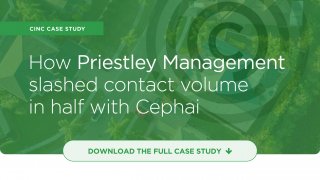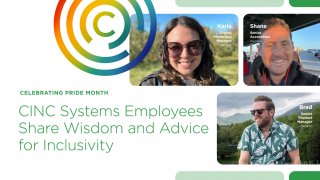- July 26, 2023
- CINC Systems

When you hear the words “Diversity, Equity, and Inclusion (DE&I),” what comes to mind? Few professionals would argue against the merits of these initiatives, but debate swirls over how to cultivate diverse, inclusive cultures in the real world. When there’s a lack of clarity around why and how an organization promotes DE&I, it’s easy to reduce it to a buzzword or prioritize other things on your to-do list.
But the community association management industry plays an outsized role in fostering inclusive workplaces and communities. As the country grows more diverse and disparities in homeownership persist, the CAM industry bears responsibility for helping create more welcoming and inclusive neighborhoods for all.
We have our work cut out for us. Racially-restrictive covenants are still found on the books in nearly every state in the U.S. Discrimination cases are rising. Black and Latino homeowners are about twice as likely to receive low appraisals, and the LGBTQ+ community also faces challenges.
These aren’t just stats. These issues are likely affecting people you know. CINC’s Manager of Talent Acquisition, Jericah Carter, shared her own challenges in finding a home as a Navy veteran.
“I served in the Navy from 2008 to 2013 and have seen some struggles with utilizing my benefits under the GI Bill,” Jericah recalled. “The lender or realtor would push different ZIP codes that were not desirable. It was very frustrating and caused me to wash my hands of it and say, ‘I’m going to do this without using the benefit.’ The GI Bill has yet to benefit me. I know fellow veterans who have experienced that as well if the color of their skin is the same as mine.”
“These stories are important to hear, especially for anyone in community association management, because it gives us further insight into understanding where our homeowners are coming from and the experience they’ve gone through just to get that house,” said Kim Pitsko, CINC’s Director of Marketing.
(Check out CINC’s Rethink Community EQ & DEI Webinar for more first-hand stories and insights).
The good news: Understanding and implementing DE& is simpler than many believe. Ultimately, it can be summed up by a Mr. Rogers quote: “In times of stress, the best thing we can do for each other is to listen with our ears and our hearts and to be assured that our questions are just as important as our answers.”
Let’s look at what DE&I means in our industry and some practical ways to implement it.
What does Diversity, Equity, and Inclusion mean in our industry?
Let’s start with defining these terms, adding context, and debunking common misconceptions.
Diversity refers to who is represented in a workplace or community regarding race, ethnicity, ability, gender, sexual orientation, neurodiversity, and beyond.
“Being diverse means having team members represented from all walks of life — whether it’s lifestyle, race, ethnicity, cultural background, socioeconomic background,” Jericah explained.
Equity means adopting fair and just practices and policies that acknowledge systemic privileges and disadvantages and work to ensure these are not predictive of opportunities or success. There’s a key distinction between equity and equality; these are not used interchangeably. Equity does not mean “colorblindness.”
Let’s look at a great example from the healthcare industry, where equity can literally save lives. Jen Hamilton, a labor and delivery nurse, took to TikTok to explain.
“I’ve seen nurses saying, ‘I’m colorblind. I don’t treat my patients any differently,’ meaning they don’t treat their Black patients worse than their White patients,” she says. “It’s not enough to be a colorblind nurse in 2023.”
Black women, she explains, are far more likely to be harmed than other races in pregnancy, childbirth, and beyond. She believes systemic racism is to blame; as Black women’s symptoms and concerns are dismissed, they’re less likely to trust medical providers and more likely to delay seeking care.
When treating Black patients, Jen works even harder to build trust, advocate for the patient’s voice to be heard, and ensure the patient and family understand the symptoms of pre-eclampsia (a leading cause of maternal death).
In the CAM industry, equity involves understanding homeowners’ unique circumstances when enforcing covenants. For example, first-time homeowners from different cultures or countries may need help understanding an HOA’s customs, norms, and rules.
“When it comes to equity in our industry, it’s incredibly important that we understand where our homeowners are coming from and come from a place of emotional intelligence and empathy,” says Kim. “That we take the extra time before we click ‘send’ on that violation letter.”
Then there’s Inclusion, which refers to a sense of community where all members feel respected and have a sense of belonging. It may sound utopic now, but at CINC, we believe our industry is in a position to change the narrative.
Here are some places to start.
Putting Diversity, Equity, and Inclusion Into Action
Promoting DEI in Your Organization
When facilitating more diverse, equitable, and inclusive communities, a good place to start is within your own CAM organization. First, let’s dispel the myth that DE&I is a “nice to have.” There is a strong business case.
First, companies prioritizing DE&I have stronger cultures and a leg-up in recruitment.
“Everyone wants to have a sense of belonging in an organization,” explains Jericah. “So by having that representation across the board — that diversity — you’re going to attract people who see themselves at that organization and think, ‘Okay, this could be my next home.’”
Businesses also benefit from diverse thinking and ideas. Companies with diverse leadership teams earn more in profits and tend to be more innovative.
Jericah drove home the importance of promoting DE&I culture, starting with the recruitment phase. Forming relationships with recruiting companies that specialize in diverse applicants is one tactic. Another step CINC takes is to “sanitize” job applications to remove details that could cause unintentional bias in the hiring process.
Takeaways for Boards and Homeowners
Just as it’s essential to work on DE&I in your CAM organization, HOA boards should be intentional about representing all walks of life — not just one group. But remember that “all walks of life” includes generational differences in understanding and embracing DE&I.
Remember that it’s okay not to “get it.” Respect and openness are far more important.
“If you accidentally use the wrong pronoun, they’re not going to freak out at you as long as you show respect,” says Kim. “It’s not about knowing all the right answers; it’s about respect and taking the time to understand where they’re coming from.”
Community managers, boards, and homeowners have tools to help educate the community about the importance of DE&I, and small gestures can go a long way in making everyone feel welcome and included.
For example, you can use the HOA Portal to share information about holidays like Pride Month and Juneteenth or offer sensitivity training for board members.
Other times, promoting DE&I might mean revisiting your processes to offer more support and education where it’s needed. First-time homeowner meetings, for example, are a great way to acclimate neighbors to the HOA and its covenants before their lack of knowledge results in violations and contention.
It all comes down to leading with empathy and EQ. Consider the example of the homeowners who were asked to remove their Pride flag and how the HOA could have prevented the negative attention that ensued by using EQ.
“Maybe the flag was a violation in some way, but it was handled wrong,” says Kim. “They could have said, ‘I love your flag, glad you’re part of our community. It can’t go here, but let me give you another suggestion.’”
Related Reads

Blog
How Priestley Management slashed contact volume in half with Cephai
- July 22, 2024

Blog
Get Ready: Homeowner Associations Must File Under the Corporate Transparency Act
- July 8, 2024

Blog
Generative AI just got a lot more mainstream. Is your community association ready?
- July 1, 2024

Blog
Celebrating Pride Month: CINC Systems Employees Share Inclusivity Wisdom and Advice
- June 28, 2024

Blog
Mid-Year Update: Using the 2024 State of the Industry Report to Drive Business Growth
- June 10, 2024

Blog
4 Ways Cephai Makes Pool Season a Breeze for Community Managers
- May 27, 2024
